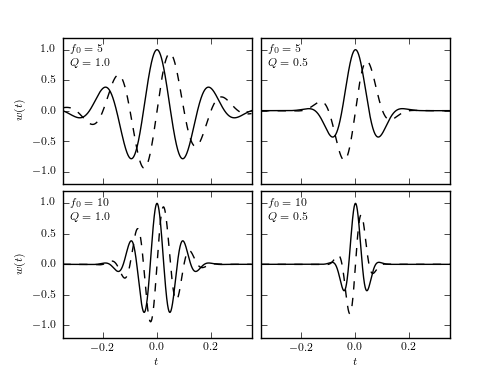Examples of Wavelets¶
Figure 10.9
Wavelets for several values of wavelet parameters Q and f0. Solid lines show the real part and dashed lines show the imaginary part (see eq. 10.16).

# Author: Jake VanderPlas
# License: BSD
# The figure produced by this code is published in the textbook
# "Statistics, Data Mining, and Machine Learning in Astronomy" (2013)
# For more information, see http://astroML.github.com
# To report a bug or issue, use the following forum:
# https://groups.google.com/forum/#!forum/astroml-general
import numpy as np
from matplotlib import pyplot as plt
from astroML.fourier import FT_continuous, IFT_continuous, sinegauss
#----------------------------------------------------------------------
# This function adjusts matplotlib settings for a uniform feel in the textbook.
# Note that with usetex=True, fonts are rendered with LaTeX. This may
# result in an error if LaTeX is not installed on your system. In that case,
# you can set usetex to False.
from astroML.plotting import setup_text_plots
setup_text_plots(fontsize=8, usetex=True)
#------------------------------------------------------------
# Set up the wavelets
t0 = 0
t = np.linspace(-0.4, 0.4, 10000)
f0 = np.array([5, 5, 10, 10])
Q = np.array([1, 0.5, 1, 0.5])
# compute wavelets all at once
W = sinegauss(t, t0, f0[:, None], Q[:, None])
#------------------------------------------------------------
# Plot the wavelets
fig = plt.figure(figsize=(5, 3.75))
fig.subplots_adjust(hspace=0.05, wspace=0.05)
# in each panel, plot and label a different wavelet
for i in range(4):
ax = fig.add_subplot(221 + i)
ax.plot(t, W[i].real, '-k')
ax.plot(t, W[i].imag, '--k')
ax.text(0.04, 0.95, "$f_0 = %i$\n$Q = %.1f$" % (f0[i], Q[i]),
ha='left', va='top', transform=ax.transAxes)
ax.set_ylim(-1.2, 1.2)
ax.set_xlim(-0.35, 0.35)
ax.xaxis.set_major_locator(plt.MultipleLocator(0.2))
if i in (0, 1):
ax.xaxis.set_major_formatter(plt.NullFormatter())
else:
ax.set_xlabel('$t$')
if i in (1, 3):
ax.yaxis.set_major_formatter(plt.NullFormatter())
else:
ax.set_ylabel('$w(t)$')
plt.show()
